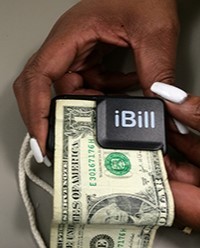Identifying US Currency For People Who Are Visually Impaired

Thanks to a lawsuit brought by the American Council of the Blind (ACB), the Treasury Department must make US currency accessible to blind and visually impaired Americans under the Rehabilitation Act of 1973. Unfortunately, the wheels of government grind slowly. According to a press release from the Treasury’s Bureau of Engraving and Printing (BEP):
The U.S. government will continue to research a raised tactile feature for use on the next redesigned Federal Reserve note and will continue to add large, high-contrast numerals and different colors to each redesigned note denomination that it is permitted by law to alter. The process for redesigning Federal Reserve notes is complex and time-intensive. Notes with any new features are not expected to be in circulation before 2020.
An Interim Solution to Currency Identification for People with Visual Impairments: The iBill Talking Bank Note Identifier
For many years, private companies have been producing currency readers that identify and announce the denomination of a bill inserted into a sensor on the device. One of these devices, the iBill Talking Bank Note Identifier, is now available free of charge from the Treasury Department to any US citizen who is blind or visually impaired.
The iBill is compact enough to slip into a side pocket. It can identify all US currency, assuming the bills are not too crumpled or otherwise damaged. It announces the denomination in your choice of three ways: It can speak the dollar amount; it can produce a different pattern of tones for each denomination; or it can vibrate silently, which may be helpful in keeping your financial information private when you use the iBill at a cash register or count your change.
To apply for a free iBill, you will need to complete an application on the BEP website. The application is available in an accessible PDF that can be filled out online. Once the form is complete, you will need to print the document, obtain the signature of a doctor or other qualified professional who can verify your visual impairment, then mail the completed application to the address on the form. Talking Books subscribers can get the iBill without filling out the application or getting a doctor’s verification by calling their state library and putting in a request.
A Mobile Solution
Along with the free iBill currency identifier, the Treasury Department has also developed a pair of mobile apps that use your Android or iOS device’s camera to identify US currency. The Android version, called IDEAL Currency Identifier, is available from the Google Play Store. The iOS version, called EyeNote, is available from the iTunes App Store.
After starting either of these apps, all you need to do is to point your phone’s camera at the bill. After a few seconds, the app will report both the currency amount and whether you are showing the front or rear face of the bill.
Other Solutions
The LookTel Money Reader for Apple iPhones, iPads, and newer models of the iPod touch is available from the iTunes Store for $9.99. You can also use your Mac desktop or laptop computer to identify currency with the OS X version, which can be purchased from the Mac App Store.
These apps operate similarly to the free versions offered from the Treasury Department, but the LookTel Money Reader will identify currencies from 21 different countries, which makes this a must-have for international travelers.
There are also several other apps that can distinguish a $5 bill from a $20, as well as a can of corned beef hash from that can of spinach you still don’t want to eat. We’ll have a lot more to say about such apps later on in this guide.
One last option we will mention here is the i.d. mate Quest from En-Vision America. This multifunction accessibility device recognizes currency, and, as you will read in the next section, a whole lot more.
This article was written and published by the American Foundation for the Blind. <Click Here> to read the article in its entirety and access other helpful articles from AFB.
We Are Here To Bring Hope
If you or a loved one have been diagnosed with Macular Degeneration, we have prepared a 12-part eBook <Click here to download a PDF of the entire report.>
To learn more about how we can Bring Hope to people who are blind or with low vision, contact a Technology Specialist at New England Low Vision and Blindness to learn more. You can also call our toll free number 888-211-6933 or email us at info@nelowvision.com.
Our two(2) state-of-the-art technology showrooms are a wonderful resource, showcasing a variety of leading electronic low vision magnifiers and blindness products. You can schedule an appointment with one of our Technology Specialist who can help you find the right technology, training and care solution.
If you cannot come to us, our staff can even drive out and bring our Vision Store to you, for a no-obligation product demonstration. We offer a comprehensive line of products including electronic magnification low vision aids, blindness products, and leading low vision products for people with glaucoma, macular degeneration and other forms of vision loss.



